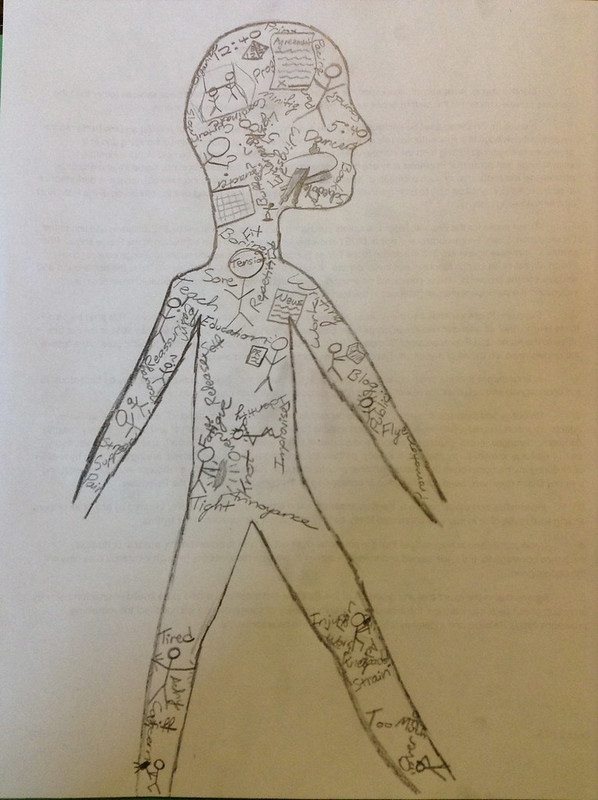The Art Assignment
We’ve recently started following a new youtube web video series called “The Art Assignment.” In it, museum curator Sarah Urist Green takes you to visit a different contemporary artist each week. After a brief interview about their art and what inspires them, the artist then gives the viewer an assignment. This opens up the conversation to the online community, as viewers all over respond by completing the assignment and posting their work to the Assignment’s youtube or facebook pages. This page details Artistic Director Ellen and the gang’s responses to each week’s assignment, starting with the most recent.
#44: Caption Contest
Going a little off-prompt for this one, but when I saw the original image to be captioned, I immediately thought that the boots looked as though they were standing in a version of a ballet First Position. So I captioned them with an oft-repeated correction called out by many, if not all, ballet teachers at some point.
I then thought about the idea of creating a dance caption as well – some kind of very short dance that would bear a similar relationship to the image that the words did. So I played with the correction “turn out from the hips” to generate a little nugget of movement that I then superimposed onto the image.
#43: Constructed Landscape
Bear with us, please – this is a long one, I know. But we had so much fun with it that we couldn’t bear to leave anything out!
For our Constructed Landscape, we started by using the random bits and pieces in the studio (most of them are actually for the yoga classes that happen at other times of the week) to construct our version of the Pittsburgh city skyline. We began our improvisation as bridges over the yoga-mat rivers, and played from there using a few basic rules:
1. Movement that was focused on shape, line, and form
2. Playing with deconstructing and reconstructing the landscape around ourselves
3. Moving the camera to different locations and perspectives as we wished
4. Thinking about transforming these very abstract objects, making them look different due to perspective or getting them to read as as many different representative landscapes as we could.
We had so much fun with this one – it was like being a kid again in many ways. In fact, one of the dancers mentioned as we were cleaning up that it was ‘a fun playground,’ which prompted the title of our assignment. If you’ve got the time, I highly encourage you to watch the whole thing!
#42: News Photographer
Coming Soon!
#41: Present Perimeter
For our response to Present Perimeter, we first discussed a few different ways to incorporate the ten shapes of the assignment into a dance improvisation. We used them in several ways throughout the piece, but our work began with the final group shape that ends the video – we wondered if there was a way to use all ten shapes with three dancers in one tableau. The sitting, interlocked arms and legs were our answer to that question.
For the rest of the improv, the dancers each took one of the shape types and tried to incorporate that shape into their movement in as many ways as possible. Artistic Director Ellen took the hexagon and provided a continuous perimeter around the space that got smaller as the piece went on, until the other three were contained within a tiny space for part two.
#40: Object Empathy
Coming Soon!
#39: Make It, Break It
For ‘Make It, Break It,’ we started with a phrase choreographed by artistic director Ellen. The dancers learned the phrase, and then Ellen went away while they went to town ‘destroying’ it in several different ways.
The biggest thing that came up out of this one was how many ways there are to define ‘destroy.’ We discussed making it cease to serve its original purpose, cease to fit into the original time, cease to fit the original physical qualities. The dancers did three variations, in order:
1. taking one of the scores from a previous work of ours, they attempted to perform it as close together as possible.
2. They took each movement individually and figured out an exact opposite of it in some way.
3. A free-for-all based on the idea of ‘marking’ the phrase, making it smaller and repeating movements.
I was particularly intrigued by the idea of taking each movement and destroying it individually. One of the dancers, speaking about the first movement, asked the others “what’s the opposite of a turn?” another one immediately responded “A jump!” and the third chimed in with “are you sure?”
I often use this type of process when creating new movement. There are lots of different ways to ‘destroy’ a movement, and the destruction can often be more interesting than the original!
#38: Fake Flyer
Coming Soon!
#37: Paper Weavings
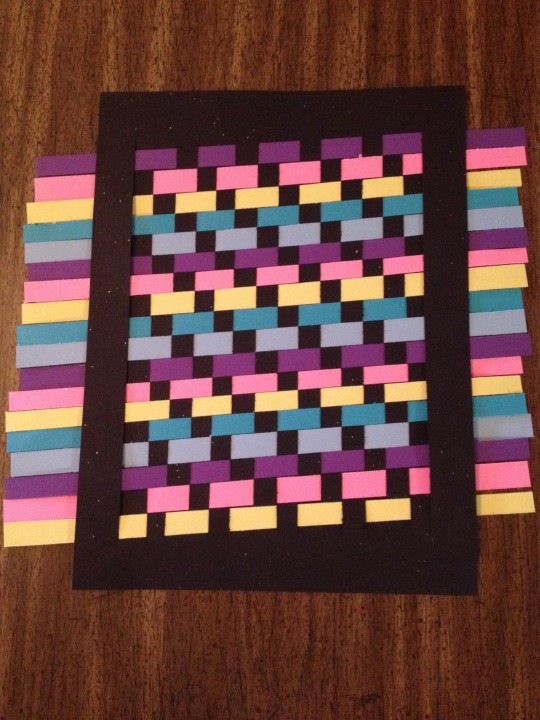

Oh man, I love this assignment! This is exactly the kind of project I like to do while watching TV, and I just so happened to have a giant pad of construction paper left over from a previous project, so I quickly got to work. I used a handheld paper cutter I keep around for making show programs and such that has a built-in ruler so I could keep everything nice and consistent(ish).
Right away, I liked the idea of the ‘warp’ sheet having a pattern on it, and playing with how much of the sheet was visible through the weave. The black one reminded me of outer space, so I chose colors that were reminiscent of a classic solar system poster and tried to get the impression of movement with the weaving pattern. And for the other one, I just had fun with the contrast of straight pieces of weave forming waves to counterpoint the waves on the warp sheet.
#36: Scramble Scrabble
Geeksdanz takes the “Scramble Scrabble” algorithm from the latest Art Assignment and uses it to create a little dance. The original assignment was to use this algorithm to create dishes for a dinner party, but we figured, why not use it to create phrases for a dance?
#35: Lost Childhood Object
The dancers of Geeksdanz interviewed each other about their lost childhood objects, and then rather than fabricating the objects tangibly, we created miniature dance solos to represent the objects and gave those back to each other as gifts of performance.
We decided after creating and presenting the solos that it would be more impactful to present the solos before the interviews in the final video, so that viewers could contemplate what kind of object each solo might represent. the second half of the video is our interview exchanges.
The music was chosen by each choreographer using my iPod’s music library, and the choices were made quickly due to the time constraints in the studio. The choreographers also chose where the object owner should sit, and we made sure all object owners were in frame in some way so that part of the impact would be watching the owner watch their gift. We considered re-recording the solos formally, but decided that it was important to keep the recording of the first time the object owner witnessed the piece to preserve their reactions.
We thought a lot about the multiple translations that the object went through during this process, from the owner’s memory of the object, to how they choose to present that memory, to how the interviewer perceived their descriptions, and then finally, the interpretation of that memory into physicality and movement. I found it surprising that all of us had varying levels of gesture in our pieces, and that almost all of the pieces had quiet, pensive tones and involved gentle, calming music. We also found it a cool coincidence that between the four of us, our objects represented a piece of clothing, a treasured soft item, a crafting supply, and a technological entertainment. In a way, we had four different categories of object represented, and enjoyed pinpointing the similarities and differences between them.
#34: HERETHERE
Coming Soon!
#33: Surface Test
Not quite the actual Art Assignment, but when I watched “Surface Test” I got very intrigued by the discussion of Icons vs. Symbols vs. Indexes. I especially like the idea of an Index as an indicator of a thing, and I started thinking about different ways to document the index of a dance.
I was originally going to simply do a rubbing of the floor in our performance space (and I might still do that if I can find the time), but then I started to think about the aspects of live performance that tend to get lost in translation. One of the big ones for modern dance especially is the use of breath and the sound of the dancers’ feet and bodies on the floor. This movement from our show always sticks in my memory precisely because of its use of breath and sound, and the way the sounds almost create another layer overtop of the original musical composition.
So, in a sort of tangential response to “Surface Test,” here is an Index of “Love Interests” from Finding Margo, Losing Gus, in the form of the audio from one of our rehearsals.
Music Credit: The music is an original composition for our show by Carly Gordon.
#32: Embarrassing Object
I am legitimately embarrassed to be posting this.
A lot of times, when people learn I’m a dancer/choreographer, they assume that I’d be the one out on the dance floor at every party. But in reality, I never liked dancing at parties, largely because I didn’t have any “moves” to do and felt like I didn’t know what to do with myself. Since working with improv I’ve gotten a little less weirded out by that, but I still often feel like I don’t really know what to do in a ‘normal’ dance situation.
This is my guilty pleasure, and rest assured I WILL instantly stop what I’m doing if someone else enters the room.
#31: Become a Sci-Fi Character
Coming soon!
#30: Boundaries
We’ve got two responses to this one! The first is by Artistic Director Ellen on her own, and the second is a collaboration between her and fellow Geeksdanzer Patty!
A little semi-improvised number I did to transform the boundary between the stairs and the hallway for the “Boundaries” assignment.
This was a trippy one to perform – something just felt so ‘wrong’ about putting myself on the other side of the banister. I kept wanting to go further over it, but worrying that I’d panic and fall off. If I had had some kind of harness, though, I definitely would have done it. That area up by the light fixture seemed so much like ‘dead’ space that had never really been inhabited; I would have loved to just suspend myself up there and really spend some time in it. As it was, though, I settled for drawing attention to the two sides of the banister, and the fact that one of them was inhabited while the other was not.
Our rehearsal space is a second-floor yoga studio with one wall of mirrors, one wall of windows looking out to a courtyard, and one wall of windows looking in to the atrium of the building. Sometimes, dancing in there can feel like being suspended in a glass box up in the air.
Patty and I worked out a piece that took advantage of the boundary between the studio and the empty space of the 2-story atrium, and used as our jumping-off point a moment in Thor: The Dark World when Thor tells Loki “No more illusions.”
#29: Make A Thing
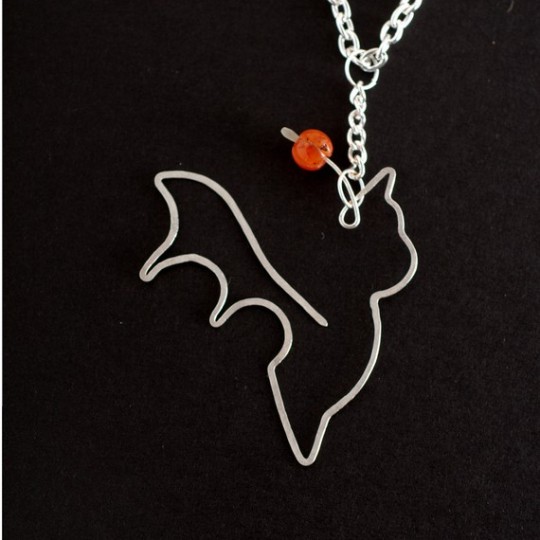
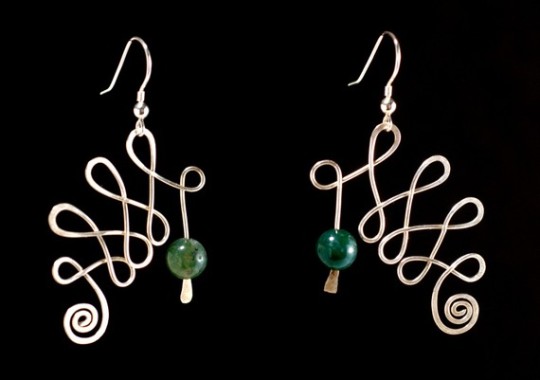
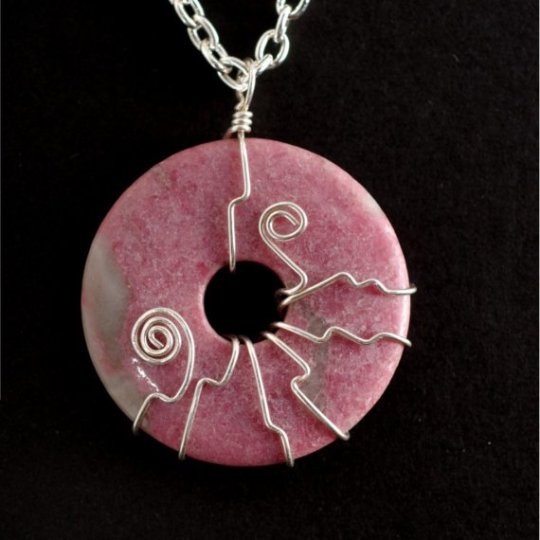
I got super excited to do last week’s Art Assignment when I realized that I’ve been doing exactly this for years! The assignment is to take something from the virtual world and make it physical, and that’s exactly what the core line of pieces in my jewelry shop is!
I make sterling silver jewelry in my spare time, and a few years ago I was going to an anime convention with some friends. I wanted to get a table to sell my jewelry, the only catch was, there needed to be something connecting my jewelry to anime or video games or the culture of the con to have it make sense. So I hit upon the idea for The Relic Shoppe.
In the video game Final Fantasy VI, one of the equipment types is “Relics.” You go to a Relic Shoppe and purchase your Relics, which are equipped in their own slot alongside weapons, armor, etc. The Relics all have names like ‘earrings’ or ‘pendant’ that suggest jewelry, and they all have one-sentence descriptions of the effect they bestow on the wearer when worn, but there’s no visual representation of them. I decided to take those names and descriptions and design jewelry pieces around them, to make those virtual equipment lists into actual physical jewelry – exactly the Assignment prompt!
The Relic Shoppe has expanded in recent years to include much more than just the Relics, but the heart and soul of my shop has always been these 25 pieces.
#28: The Muster
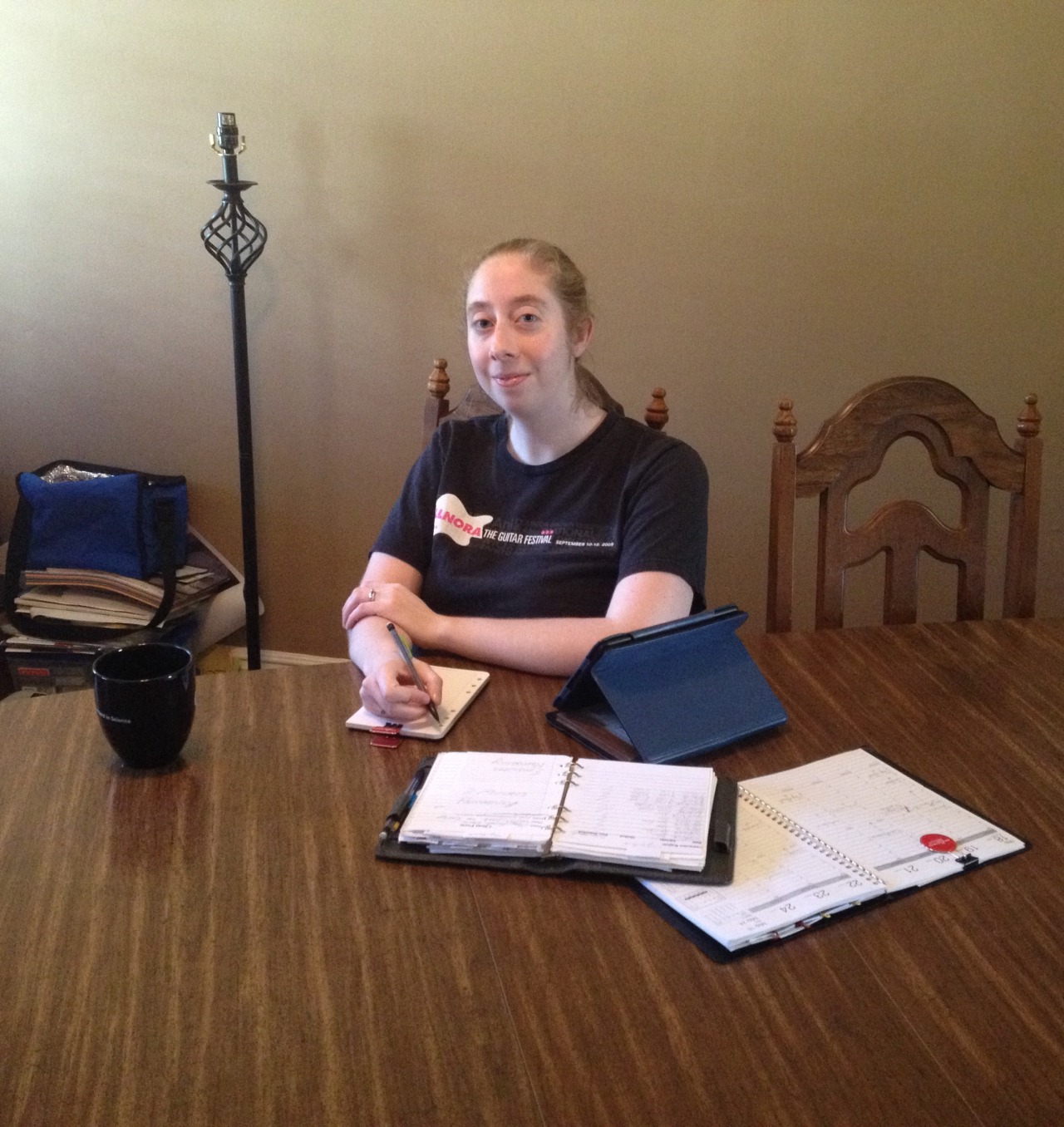
My Motto:
I fight for education and learning new things!
My Uniform:
So I’ve been dragging my feet on doing this one, primarily because I couldn’t think of a good way to do my uniform. After reading a response that chose not to include a picture but just describe it, I realized the problem: I don’t believe that education HAS a uniform at all. I made a conscious choice when I started tutoring to come to lessons in casual clothing, jeans and T-shirts, the things I usually wear. I don’t get dressed up for lessons because I want to communicate that you don’t need to wear a suit and heels in order to do math. You can learn something exactly as you are; all you need is your brain and your desire to learn. So my uniform is what I happened to be wearing today, plus all of my tutoring ‘props’:
- My appointment book with my week’s lesson schedule and an assortment of business cards in it
- My tutoring binder with contact info and planning notes for my current and past students
- My iPad in its case/stand for finding math worksheets online, reading classics for English Lit students, and watching Crash Course videos
- My notepad and pencil for demonstrating and writing down notes as we work
- A tasty beverage
My Declaration:
Everyone has the ability to learn new things, and everyone should be given the chance to learn and improve. Learning broadens your horizons and gives you the ability to think critically about life and your place in it. It allows you to find fuel from the world to further your personal passions, and funnel those passions back into the world in response.
Learning allows you to be constantly growing and evolving and experiencing more new things as you live your life. It gives purpose and context to the daily experience of living. Learning keeps life from becoming a chore.
Being excited to learn means you’re excited to be alive! Be excited about life! Be excited to learn!
#27: Collaborate with Son Lux
When listening to Son Lux’s composition, we were struck by two prominent, contrasting textures: the calm, lyrical quality of the melody, and the harsh, crunchy texture of the backbeat. We decided to do a counterpoint duet showcasing both of those textures, and trading off who did which one. I pointed out to Patty that the crunchy texture reminded me of a classic dance texture, where a dancer “crumples” jarringly as though every joint in her body were failing in sequence. It’s become a very common, almost cliche, way to get a dancer to the floor from standing, and I wanted to turn that cliche on its head. What would happen if we tried to “crumple” UP from the floor TO standing instead of falling down? (In fact, I almost called this piece “Crumple UP!” but thought that might be a bit too on point and give away too much.)
After a few runs of the original concept with Son Lux’s music (one of which I’ve placed at the end of the video), we decided to mix it up and try the same concept with different music; something that was as far opposite of Son Lux’s composition as we could find. We hit upon this piece in my catalogue and grinned at each other, saying “Let’s give this piece a narrative that doesn’t really exist!”
#26: Customize It
For our response to ‘Customize It,’ we decided to start with the idea of so-called ‘common objects’ – in the assignment video it’s meant literally as a tangible object that you’d have around the house, but we figured, why not a common dance move that you’d find around the studio?
Artistic Director Ellen put together a short phrase composed of very stereotypical modern dance class moves – things you see in class but not much in performance – and then she and Lamar sat down and made lists of attributes of each move, either from an audience perspective or from a class-planning perspective (i.e. when a teacher puts this move in a combination, what is she trying to accomplish in terms of the class?) We then each picked one attribute from each list and played with modifying the movement by changing that attribute to create two separate customized phrases. The structure followed naturally from there.
We quickly realized that Lamar’s custom phrase took much less music than Ellen’s, in part because Lamar ended up speeding up the slow parts of the phrase and Ellen ended up slowing down the fast parts. We decided to emphasize that difference by having Ellen only complete her custom phrase once, while Lamar made it through his three times in a row.
#25: Artistic Alchemy
The latest Art Assignment is to take something that’s been discarded, think about the story behind it, and breathe new life into it.
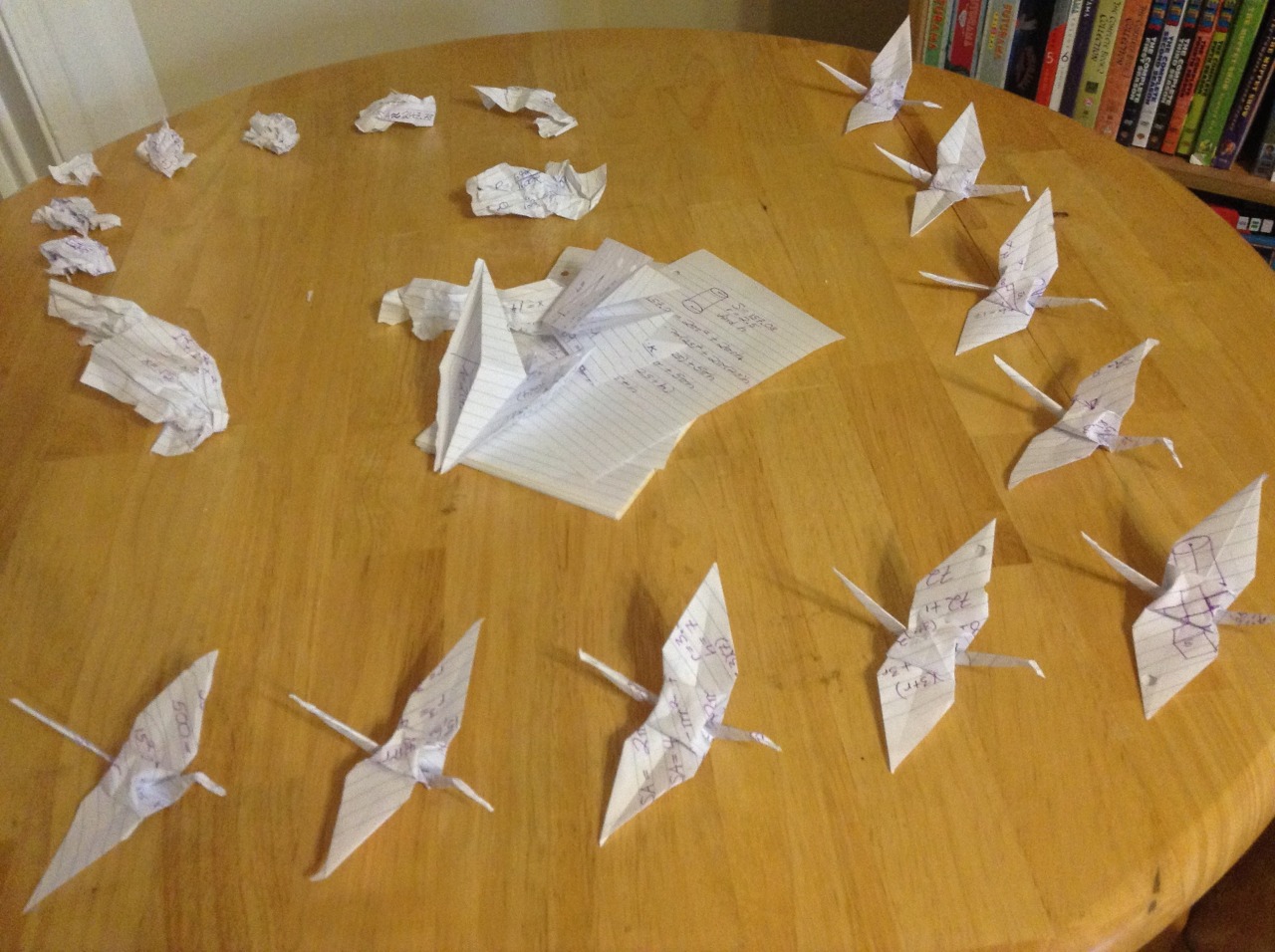
Hearing this assignment, I immediately thought about my job as a private tutor. In the course of my lessons, I go through A LOT of notepaper. I usually keep old notes around for several months after I stop working with a student, in case I need to refer to them later, but for all intents and purposes they’ve been discarded. I dug through my file folder and found a sheaf of notes from several years ago that had no business still being around – or did they?
My first thought was to fold the paper into some kind of origami, so I played around with flowers for a while. Then I thought about paper cranes, and the Japanese custom of folding 1,000 paper cranes and receiving a wish. I also started to think metaphorically about my job as a tutor – I take the raw material of a student and fold and shape it, to give them a few new skills and hopefully a fuller knowledge of those skills’ context in the world. I liked the resonance of these discarded sheets of paper gaining wings and taking flight, so I arranged them in the traditional V of a flight of geese.
Then I looked to my left, where I had a small pile of scraps of leftover paper – the notebook pages are rectangular and the crane begins with a square of paper, so there were little extra pieces to tear off of each one – and thought about the discarded bits from this activity. I realized that any activity that enriches you also requires you to shed some piece of who you were before, whether that’s the idea of yourself as “not a math person” (in the case of some of my students) or a preconceived notion (such as what is and is not “art”), or a physical change that leaves you looking unfamiliar to yourself. Our paths in life are strewn with these discarded bits of self, so I added a reflected V of the cranes’ discarded paper to balance the composition.
I wanted to actually suspend the cranes in midair as though in flight, but I couldn’t figure out a good way to do it in my living room. If I had been creating this for a gallery setting, though, I picture this composition as taking off from the table, with the V of cranes gradually increasing in height as they approach the leader.
#24: Assembly Line
THE RULES:This is a warm-up exercise that I stole from one of my college dance professors. I have choreographed a short phrase that loops from right to left. With no explanation ahead of time, I put the music on and start running the phrase. The first time through, right and left, the dancers are NOT ALLOWED to mark – they must simply watch and retain as much as possible. After that run, they can begin marking along with me to learn the phrase. Once they feel confident in the phrase, they join in. When everyone has joined in, I drop out and they continue on their own.
I decided to show you our Run-Around warm up process because while watching the Assembly Line assignment episode, I kept thinking about the ways in which this exercise is sort of like an assembly line. In this case, the final product is the phrase itself, and after the process of figuring out the phrase, the dancers are cranking out run after run of the phrase as if on an assembly line. I also felt like the middle section, where we do questions and corrections after the fact, was akin to the assignment episode’s discussion of standardizing the process to achieve a uniform look.
The discussion of uniformity is also fascinating to me; one of my biggest anchoring ideas in running my company is the idea that each dancer is an individual with different experiences and body types, and that the same phrase will look different on different bodies. I’ve seen “cookie-cutter” companies that strive to have everyone achieve a uniform look, and I’d rather see the real person behind the dancer. You’ll hear me near the end of the video encouraging the dancers to make certain movements their own, to take small, specific liberties with the choreography to let their personality shine through.
#23: Become Someone Else
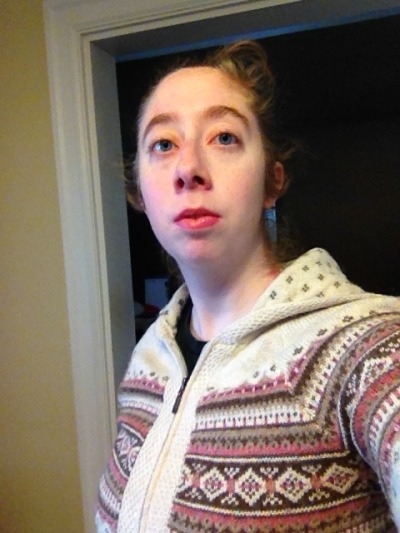
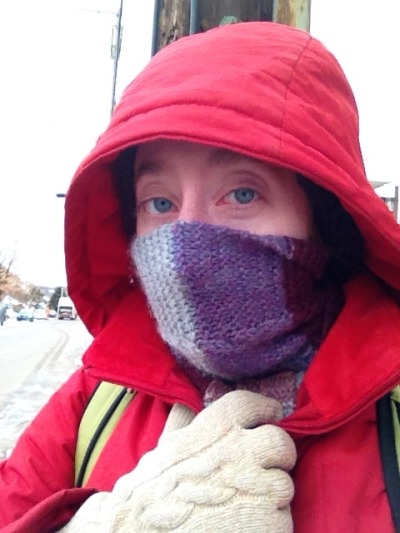
It’s cold outside. And I’ve noticed that I tend to behave differently when I’m outside in the cold as opposed to inside in the warm. I wondered if I looked as different as I felt, so I figured I’d do this as my Art Assignment. There might be another one in the near future based on the idea of changing outfits – I’ve got a lot of different dress styles that make me feel very different when I wear them, so there’s definitely potential.
#22: Encounters
This assignment is simply to facilitate an encounter between two of your friends who do not know each other, and suggest a collaboration of some sort. I decided to introduce one of my current company members to one of my fellow U of I dance department alums because I felt their dance styles would mesh well together while still being very unique and different from each other. As far as I know, nothing has yet come from the encounter, but I only recently introduced them. I’ll keep you posted!
#21: Movement Telephone
I wanted to do two runs for several reasons. First, the first run was based on a non-dance video, and the second based on a dance video. I wanted to see if the consistency from run to run would be higher if the original material was in a discipline that Patty was already familiar with. Second, the second run was considerably longer than the first one, and I wanted to see if the length would affect consistency of movement. The second run was also of a duet originally, and I was curious to see how Patty would choose to adapt the duet movement as a solo.
Here’s my thoughts on those questions. First, the length definitely seemed to affect the consistency; the shorter one stayed much more true to the way it started out, with the only real changes being in the exact footwork of the jump and the slide to the floor. However, being in a non-dance discipline made Patty’s initial rendition of the archery video further from the original in the first place. And while the second one involved moves that were already in Patty’s physical vocabulary, that in some ways allowed for more development as she watched each progressive video. The sequence of releves in arabesque (that first show up at 0:45 seconds in) were originally her attempt to simply stay on releve – the original was a duet and that move was supported by the partner she didn’t have. As she went on, though, the releves became a movement in their own right, and she began to put more emphasis on them each time.
This assignment made me think of when I worked with Alonzo King in high school. He used a similar process to generate movement – he would improvise a phrase for us one single time, and then have us repeat it back to him. Watching a classroom full of dancers try to emulate something he came up with off the top of his head helped him to eliminate the filler material and use only the pieces that everyone got down. That jump, that turn, that complicated arm thing – those were the important parts of the phrase. All that footwork getting from A to B could get left by the wayside, since if we each had something different it couldn’t have been that clear in the first place.
#20: Emotional Furniture
This week’s assignment was to create three compositions that depict three specific emotions, using only furniture. The emotions are, in order: envy, melancholy, and confidence.
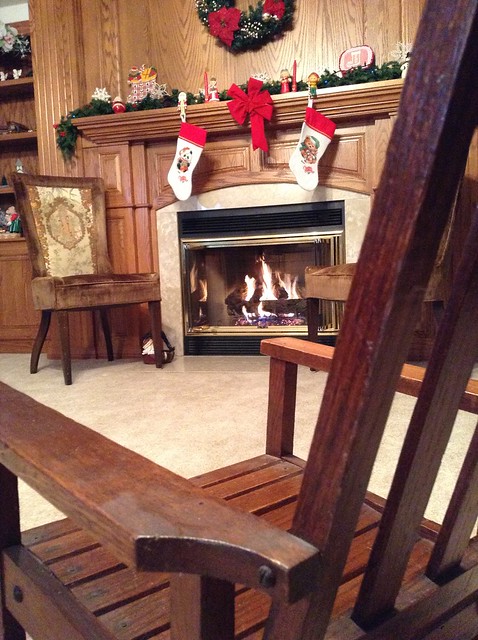
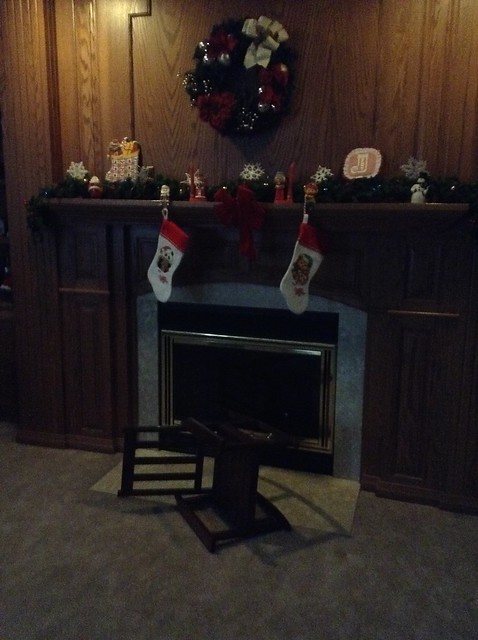
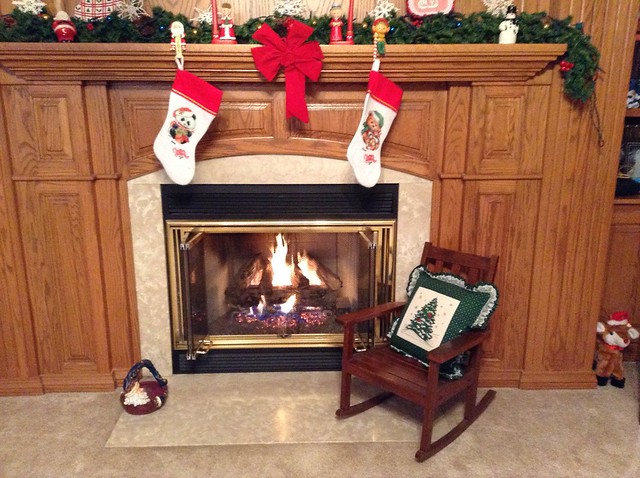
#19: Relative Strangers
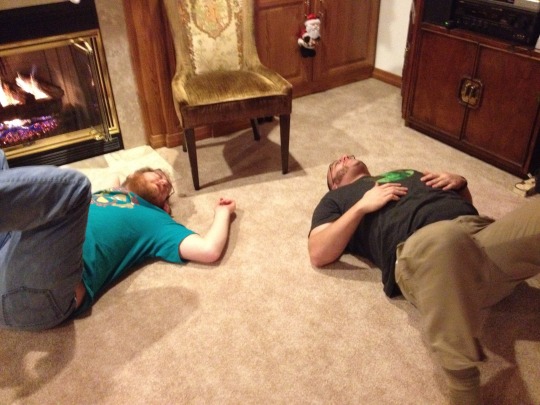
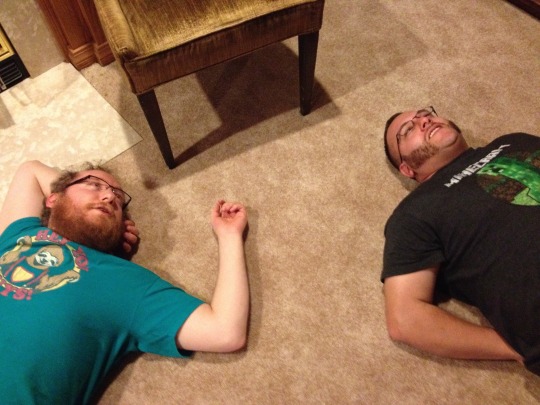
My response to the Art Assignment’s “Relative Strangers.” I went a little off-prompt this time. I was all prepared to take photos of my rarely-seen distant relatives at our Christmas gatherings yesterday, and yet all I could think about was the ability of best friends to feel more like family than genetically-related people ever could. My husband (on the left) has many not-really-related-but-family-nonetheless people in his life, and the conversation often flowed much more freely with those people than with distant relatives. So for my response to the Assignment, I’m presenting the flip side of the idea: genetic strangers that are closer than family.
This is my husband and his closest friend, hanging out on his birthday and chatting about random things.
#18: Expanded Moment
This week’s assignment was to find a location with the potential for movement, and then set up the camera and film for two minutes without sound. I might technically be cheating with this one, since obviously a dance rehearsal is going to have movement, but here it is anyway.
#14: Find Your Band
This week’s assignment was to “find the band” in an everyday location, and then join in.
#13: Sorted Books
This week’s assignment was to look through someone’s book collection and sort them into three piles so that the titles, when read in order, say something about their owner’s personality.
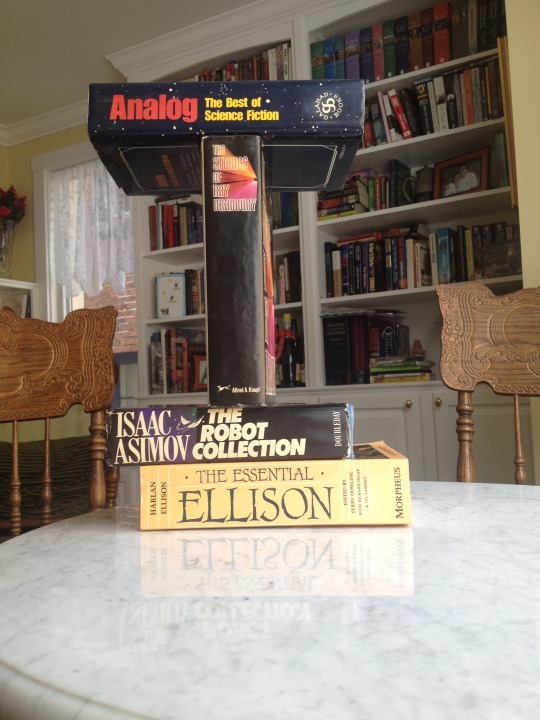
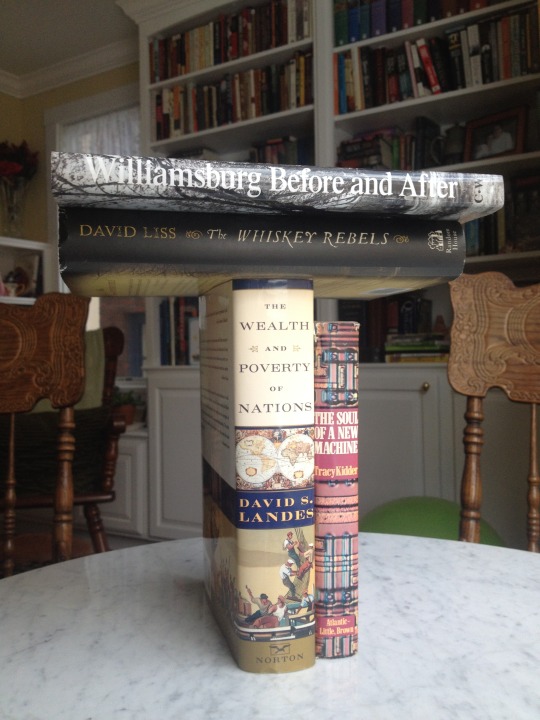
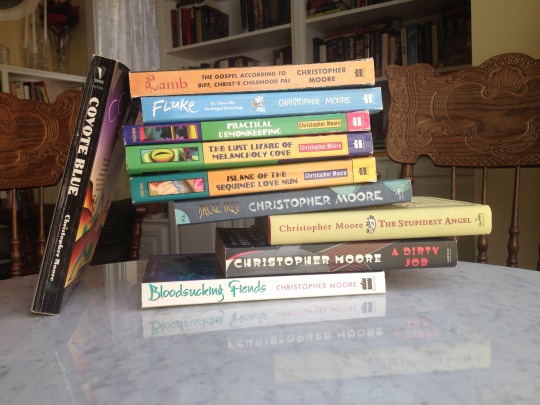
Now that my mom’s new house is finished and her books are back on shelves (some of them, anyway), I did the sorted books assignment to characterize my mom. Thinking more about lighting and composition this time, as per Sarah’s instructions!
The first thing I noticed about my mom’s bookshelf was that it was very author-focused. I’d see whole shelves dedicated to her favorite authors, and anthologies full of the big names. So I tried to capture some of that with the first and third photos.
Sort 1:
Analog: The Best of Science Fiction / The Stories of Ray Bradbury / Isaac Asimov: The Robot Collection / The Essential Ellison
Sort 2:
Williamsburg Before and After / The Whiskey Rebels / The Wealth and Poverty of Nations / The Soul of a New Machine
Sort 3:
Bloodsucking Fiends / A Dirty Job / The Stupidest Angel / Sacre Bleu / Island of the Sequined Love Nun / The Lust Lizard of Melancholy Cove / Practical Demonkeeping / Fluke, or I Know Why The Winged Whale Sings / Lamb: The Gospel According to Biff, Christ’s Childhood Pal / Coyote Blue
#11: Under the Influence
This week’s assignment was to create something in the style of someone who has influenced you. I chose to complete this one two ways: I did a solo improvisation in the style of one of my favorite choreographers, and then set this assignment as a warm-up improv score for the dancers. You can check out both of the results below.
#9: Off
This week’s assignment was to find a screen, turn it off, and then take a picture of the reflection you see in the turned-off screen. I see this view quite often when our TV is off.
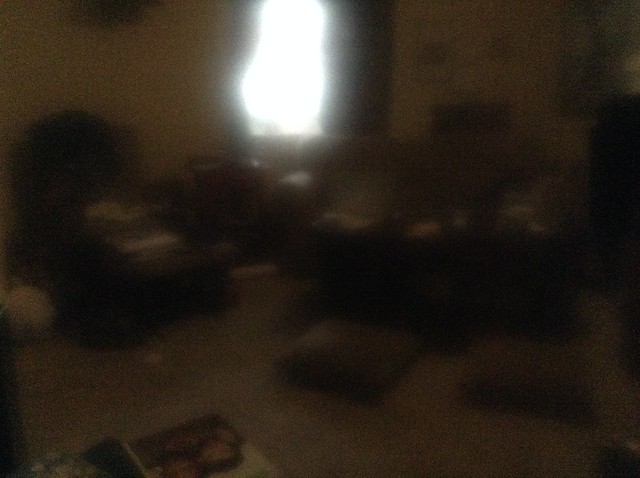
A few months after completing the assignment, I posted this on our Tumblr as well:

Off?
Okay, this is not exactly what the “Off” Art Assignment is supposed to be, but it certainly reminds me of it. I was waiting for the bus this morning when I noticed this reflection. There’s a lot of plate glass in the architecture of Pittsburgh (due to Pittsburgh Plate Glass Company’s presence, of course), and there’s also a lot of history in the city. I was struck by the contrast between the clean, modern lines of the Institute building and the reflected ornamental arches of the cathedral across the street. It also got me thinking about the idea of the Software Engineering Institute, which by definition works with new technology, contrasted with the Catholic church, which is steeped in old tradition. Just another reason I love this city!
#8: Walk On It
This week’s assignment was to get a piece of cardboard and a pair of fabulous shoes, and walk all over it to damage the cardboard. You were supposed to paint the cardboard, but I never managed to get to a store to buy paint, so I left mine bare. I’m actually glad I did, since having the flexibility of the cardboard made it bend and crease as I danced on it.
#7: What, How, Where
This week’s assignment was to play the game “What, How, Where” and then complete the activity that it tells you to.
#6: Psychological Landscape
This week’s assignment is to create some kind of landscape using the Figure/Ground technique. I quickly latched on to the idea of a psychological landscape, and decided that since I’ve been in kind of a stressed out mode during this last push toward our big show I should do a landscape that represents my psychological state right now. Click the photo to open up a larger image in a new tab.
As you can see, I’m a bit stressed out right now. I decided the Ground should be a body, since as a dancer I tend to experience my mental and emotional states throughout my body, not just in my brain. Though, as you can see, most of it is in my head right now. For the Figures I’ve got questions, To-Do lists, worries, and what-ifs, as well as strains, injuries, soreness, and fatigue. Since part of the assignment was to give your figures human-like qualities, I decided to anthropomorphize some of my stresses as little stick-figures. Note the little people banging on my shins!
I found this assignment to be a particularly apt way to articulate myself right now. F.M. Alexander once said, “You can translate anything, whether physical, mental, or spiritual, into muscular tension.” I’m definitely feeling that right now, and I hope my assignment communicates that.
#5: The Quietest Place
This week’s assignment was to leave your house and go for a walk, trying to find the quietest place you could. Of course, just after I started out for my walk, it started to rain – and finding a quiet place became a bit of a challenge.
#4: Never Seen, Never Will See
This week’s assignment was to articulate something that you’ve never personally seen, and suspect you never will see. Because of the wording of the assignment, I decided that I should articulate something that doesn’t exist in the visual realm, something that I know exists because I’ve experienced it, but that I will never be able to actually see. I chose the Alexander Technique concept of “direction.”
#3: The Intimate, Indispensable GIF
This week’s assignment is to create a GIF of something that you consider “Intimate and Indispensable” to you as a person.
I took the assignment to the dancers this afternoon, since for me my Intimate Indispensable is dance, and as I suspected, so was everyone else’s. We did a long improvisation based on the question of what specifically about dance makes it indispensable to each of us, and followed it up with a long discussion of the thoughts we’d worked with. Since a single GIF doesn’t give much time to explore these thoughts, I created a series of GIFs and thought I’d pair them with a blog post detailing our conversation. I’ll also include the video of the full improvisation at the end of this post, for those interested in seeing the whole thing – warning: it’s nearly 40 minutes long!
The first thing that came up in our discussion after the improv was how connected we all felt throughout the 40 minutes. Working with such an intimate concept kept us close and made us hyper-aware of what everyone in the space was working with at any given moment. We went around the group and talked about the thoughts we’d had running through our heads, and looked for common themes. Jackie (black sweater) mentioned playing with stillness, and giving herself the permission and the space to just be still within the dance and really embody it fully. Angelina (hot pink) listed off a series of questions, including “Where do the impulses to dance come from?” and “What is ugly, what is beautiful?” I (green) listed off qualities of dance that I felt particularly close to, including momentum, emotion, and the real person behind the dance.
We all played at various times with pushing our boundaries, Jackie testing the limits of her stretches and reaches and Angelina exploring how far she could go into pedestrian movement and still be dance. We discussed the idea of real-time choreography; our hyper-awareness making it easier to react to each other and toss motifs around the room to create a cohesive whole. We touched briefly on the distinction, or lack thereof, between performing and rehearsing, and the difference between being inside the dance and observing it.
Finally I brought up the idea, originally presented to me by a favorite teacher, that dance is unique among the arts because it is ephemeral. Every performance is different, and watching a video is never quite the same as being present in the room while the dance occurs. Being inside an improvisation means that we will never know quite what the experience of watching it was like, even if we watch the video. That thing can never happen again.
When asked to distill their answer to the original question down as succinctly as possible, Jackie answered that she felt improvisation was her Intimate Indispensable. If asked to eliminate improvisation from her life, she would not be able to. Angelina felt that it was impossible to narrow down her Intimate Indispensable further than Dance, in its entirety. Everything from improv to tap to bad dance movies is part of the dance that shapes who she is. And for me? I think working with others is my Indispensable. I’ve spent time creating alone, making solo after solo with no-one to bounce ideas off of, and it’s not something I’d like to return to. I need that feedback that only other dancers can provide, both in improv and in choreography.
You can check out our whole improv below.
#2: Stakeout!
This week’s assignment was to leave an interesting object in a public place, and then observe what happens – does anyone take it or interact with it?
Since the artist in this assignment caps off her social actions with drawings, I thought I’d cap mine off with a dance. So here’s part two: “Forsaken Bubbles”
#1: Meet In The Middle
Lamar and I felt like improvising in the studio yesterday, so we put together a quick improv score for Meet In The Middle.
The score begins with us in separate physical spaces, working with contrasting textures, tempos, and levels. One person stays at high level while the other moves at low level, and if one person changes, the other has to switch to accommodate. One person moves quick and staccato while the other moves slow and sustained, and we take our changes from each other on that as well, independently of the level changes.
Midway through the video, the score develops to gradually bring us closer together before finally meeting in the middle of the space for a proper duet. Contact is allowed, and we take our tempo and texture changes as a pair instead of contrasting each other. What originally started as a darker-feeling pair of solos now becomes a lighter, more fun duet, finishing as a hint of goofiness creeps in.
We really enjoyed this score – it was great to just improvise together again in a way we haven’t done for a while. Also, this is not the original music we used in the studio, but it seemed to fit just about perfectly.
